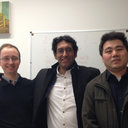[Analysis of 2 cases of dyspnea happening after tracheotomy and the clinical application of Mimics 10.01].
Palavras-chave
Resumo
Post-intubation tracheal stenosis was a late time complication after tracheotomy but the happening of dyspnea was unusual. Diagnosing tracheal stenosis after incubation, and figuring out the location and causes of the stenosis were important. Treatment of post-incubation tracheal stenosis relied on accurate diagnosis of the type of tracheal stenosis. Computed tomography (CT) and laryngoscope could be used for detecting the stenosis but not enough. Two patients who were already under the urgent tracheotomy over 1 year were reported. However apnea was found on these two patients for a long time after traheotomy. Obviously laryngeal obstruction appeared. CT virtual bronchoscope and laryngoscope examination showed that the cannula was obstructed and plenty of granulation tissue blocked the orificium. But the exact location of the cannula and the adjacent relationship of the tissue around the cannula was equivocal. Mimics 10.01 software was used to analyze the data of the CT scan and found that a pseudo cavity was formed by granulation tissue which partly blocked the cannula in 1 case; granulation tissue occupation and scar formation in the trachea were the reason of tracheal stenosis but not the collapse of the cartilage in case 2. The purpose of this report is to discuss the cause of dyspnea after emergency tracheotomy, its diagnostic method and their management. CT virtual bronchoscope and laryngoscope should be used as a regular examination after tracheotomy to clarify the location of cannula and avoid the failure of airway opening caused by the dislocation of cannula and the complication. Trachea tissue should be protected properly during and after the tracheotomy which might decline the rate of the tissue remodeling, tracheal stenosis and dyspnea after surgery. The clinical use of Mimics 10.01 made it possible to observe morphology more directly by invasive examination and provided a significant clue to make the operation plan so that it should be used widely. Meanwhile, the method to put the cannula into its right way under the guidance of rigid endoscope and the excision of granulation tissue by semiconductor laser should become one of the best treatments of this disease. Following the method above, laryngeal obstruction was relieved after the surgery. Postoperative follow-up lasted for 1 year and recurrence was not found.


